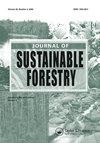Farmers’ Intentions Toward Sustained Agroforestry Adoption: An Application of the Theory of Planned Behavior
IF 1.8
4区 农林科学
Q3 FORESTRY
引用次数: 5
Abstract
ABSTRACT Adoption of agroforestry, which is a combination of growing perennial trees along with crops and/or livestock in spatial and temporal arrangements, is recommended for improving the livelihoods of smallholders. Alike several other technologies, the adoption status of agroforestry innovations in sub-Saharan Africa is considered poor. Studies have shown that plethora of biophysical and socioeconomic variables affect adoption of agroforestry innovations. In these studies, the contribution of psychological variables determining the voluntary decision-making on agroforestry adoption decisions is often neglected and marginally explored. This paper aims at exploring the role of psychological variables for the sustained agroforestry adoption intention. We employed the Theory of Planned Behavior (TPB) to predict sustained agroforestry adoption intentions of 327 farmers in the Amhara region of Ethiopia. Intention for sustained agroforestry woodlots adoption is assessed by employing the confirmatory factor analysis. Farmers’ intention to sustain adoption of agroforestry woodlot innovations is principally driven by their positive evaluation of the cash and livelihood benefits of the innovations (attitude) compared to traditional farming, their own capability to produce the innovations and accessibility of resources (perceived behavioral control), and the farmers’ perception of pressure and expectations from experts and important others (subjective norms). By employing TPB, this study brings a theoretical contribution to the TPB framework and measurement guidelines, unveils limitations of applying confirmatory factor analysis in a ‘new’ (woodlots) context and suggests data-based policy and development implications.农民持续采用农林产品的意愿——计划行为理论的应用
建议采用农林业,即在空间和时间安排上将多年生树木与作物和/或牲畜相结合,以改善小农的生计。与其他几种技术一样,农林业创新在撒哈拉以南非洲的采用状况被认为很差。研究表明,过多的生物物理和社会经济变量影响农林业创新的采用。在这些研究中,决定农林业采用决策的自愿决策的心理变量的贡献往往被忽视和很少探索。本文旨在探讨心理变量对持续农林业采用意愿的作用。本文运用计划行为理论(TPB)对埃塞俄比亚阿姆哈拉地区327名农民的持续农林业采用意向进行了预测。采用验证性因子分析评估持续农林业林地采用的意向。农民持续采用农林业林地创新的意愿主要受到以下因素的驱动:与传统农业相比,他们对创新的现金和生计效益(态度)的积极评价,他们自己生产创新的能力和资源的可及性(感知行为控制),以及农民对专家和重要其他人的压力和期望的感知(主观规范)。通过采用TPB,本研究为TPB框架和测量指南带来了理论贡献,揭示了在“新”(林地)环境中应用验证性因子分析的局限性,并提出了基于数据的政策和发展建议。
本文章由计算机程序翻译,如有差异,请以英文原文为准。
求助全文
约1分钟内获得全文
求助全文
来源期刊

Journal of Sustainable Forestry
Social Sciences-Geography, Planning and Development
CiteScore
3.90
自引率
12.50%
发文量
42
期刊介绍:
Journal of Sustainable Forestry publishes peer-reviewed, original research on forest science. While the emphasis is on sustainable use of forest products and services, the journal covers a wide range of topics from the underlying biology and ecology of forests to the social, economic and policy aspects of forestry. Short communications and review papers that provide a clear theoretical, conceptual or methodological contribution to the existing literature are also included in the journal.
Common topics covered in the Journal of Sustainable Forestry include:
• Ecology, management, recreation, restoration and silvicultural systems of all forest types, including urban forests
• All aspects of forest biology, including ecophysiology, entomology, pathology, genetics, tree breeding, and biotechnology
• Wood properties, forest biomass, bioenergy, and carbon sequestration
• Simulation modeling, inventory, quantitative methods, and remote sensing
• Environmental pollution, fire and climate change impacts, and adaptation and mitigation in forests
• Forest engineering, economics, human dimensions, natural resource policy, and planning
Journal of Sustainable Forestry provides an international forum for dialogue between research scientists, forest managers, economists and policy and decision makers who share the common vision of the sustainable use of natural resources.
 求助内容:
求助内容: 应助结果提醒方式:
应助结果提醒方式:


